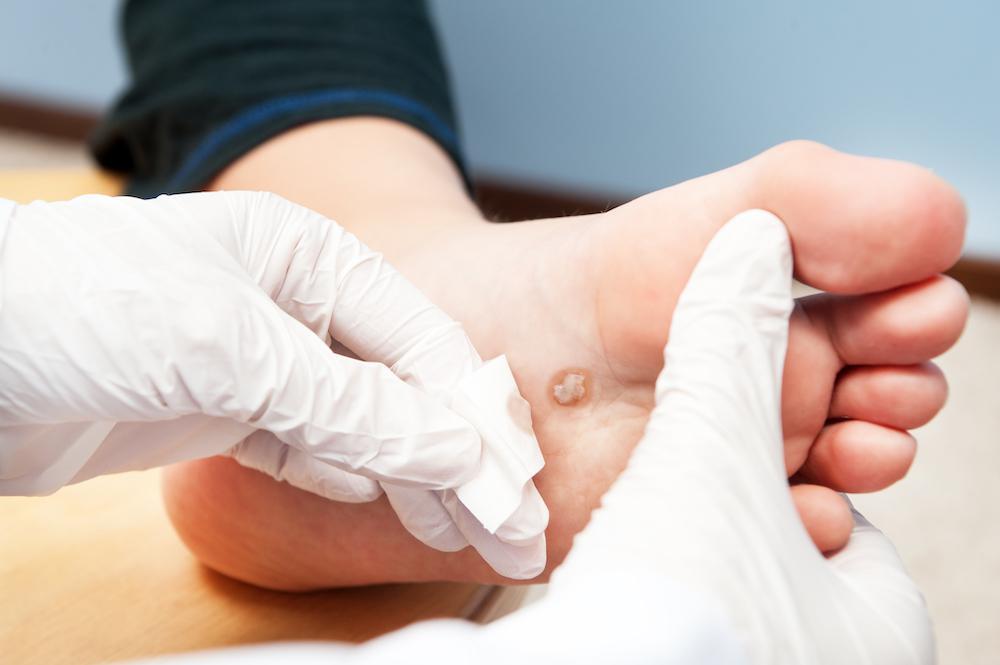An ulcer is defined as a breakdown of skin that may extend to involve the subcutaneous tissue or even the muscle or bone. These lesions are common, particularly on the lower extremities. Ulcerations associated with diabetes are the most common cause of foot ulcers. Most of these ulcers are a direct result of loss of sensation secondary to neuropathy.
Fact: Approximately 26 million Americans suffer from diabetes, and at least one-third of the medical costs associated with this disease are specific for the treatment of diabetic foot ulcers.
Fact: Approximately 85% of lower limb amputations are preceded by non-healing foot ulcers, making the prevention of diabetic foot ulcers and their recurrence the most important topic in diabetic foot disease.
Fact: Up to 60% of patients with a previous history of an ulcer will develop a recurrent wound.
Risk Factors for Diabetic Foot Ulcers:
Having diabetes mellitus
Having high blood sugar interferes with wound healing
Foot deformities, including claw toes, spurs, bunions, Charcot foot, etc.
The concern is repetitive stress to an area makes skin vulnerable to breakdown.
Neuropathy, or loss of sensation
It is likely to not realize there is an ulcer, or skin breakdown, because you don’t feel it which causes a delay in diagnosis and management
Peripheral artery disease
There is insufficient oxygen available to assist in healing or fighting infection
Previous wounds or ulcers
This is especially significant for patients with wounds that have occurred in the past spontaneously or without known injury verifying risk for developing new wounds
Previous amputation ranging from minor (toes) to major (below the knee)
There is a 50% likelihood of similar amputation to opposite extremity within 5 years.
Obesity and malnutrition
Increases the stress across the foot and low protein contributes to edema.
Smoking
Evidence shows smoking doubles the risk of wound complications
Common sense “do’s and don’ts” of foot health and wound prevention
DO
- Keep feet and legs clean and moisturized
- Have toenails clipped and calluses shaved by your podiatrist
- See your podiatrist for any deformities for treatment before an ulcer occurs
- Wear appropriate protective footwear
- Wear white socks to recognize drainage, and inspect feet daily after removing shoes
DON’T
- Walk barefoot
- Wear flip-flops
- Wear new shoes without checking frequently for pressure sores
- Neglect innocent-appearing foot wounds
- Smoke
- Use dry heat or soak feet in hot water
- Use sharp objects to remove calluses or trim ingrown nails.
Prevention of Diabetic Foot Ulcers is the Goal:
The diagnosis of diabetes does not have to equate to future lower limb amputations. A large percentage of these problems may be preventable by routine podiatric care, recognizing risk factors, and implementing essential prevention measures before these wounds occur. Because of the complexity of diabetes, the effects on skin and toenails are best managed by a podiatrist.
Discuss with your podiatrist simple procedures which can be performed in-office to optimize foot health. There are proactive surgical steps, for example, correcting the foot deformity to relieve pressure, which can be taken to prevent future ulcerations or amputations.
Patients that have diabetic ulcers need to be treated aggressively with the latest technology to get the ulcers to heal. There are many new advances in treatment options now available, like artificial skin grafts that stimulate the body to heal, different types of off-loading walking boots, hyperbaric oxygen therapy, aggressive surgical debridement of the wound to get to a healthy base to allow the wound to heal faster, just to name a few. Once wounds are healed, it is important to advise the patient in getting proper off-loading footwear to prevent future recurrence. The faster a wound heals, the sooner one gets back to an improved quality of life.
To learn more about diabetic foot ulcers and their latest treatment options, or any other foot concerns, call Dr. Manooj Prasad at: (732) 557-9900.
Disclaimer
This information has been prepared by the Consumer Education Committee of the American College of Foot and Ankle Surgeons, a professional society of over 6,000 foot and ankle surgeons. Members of the College are Doctors of Podiatric Medicine who have received additional training through surgical residency programs.
Toms River Diabetic Wound Care Specialist
Podcast: Play in new window | Download

0 Comments